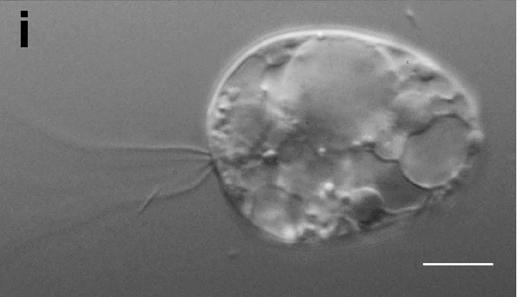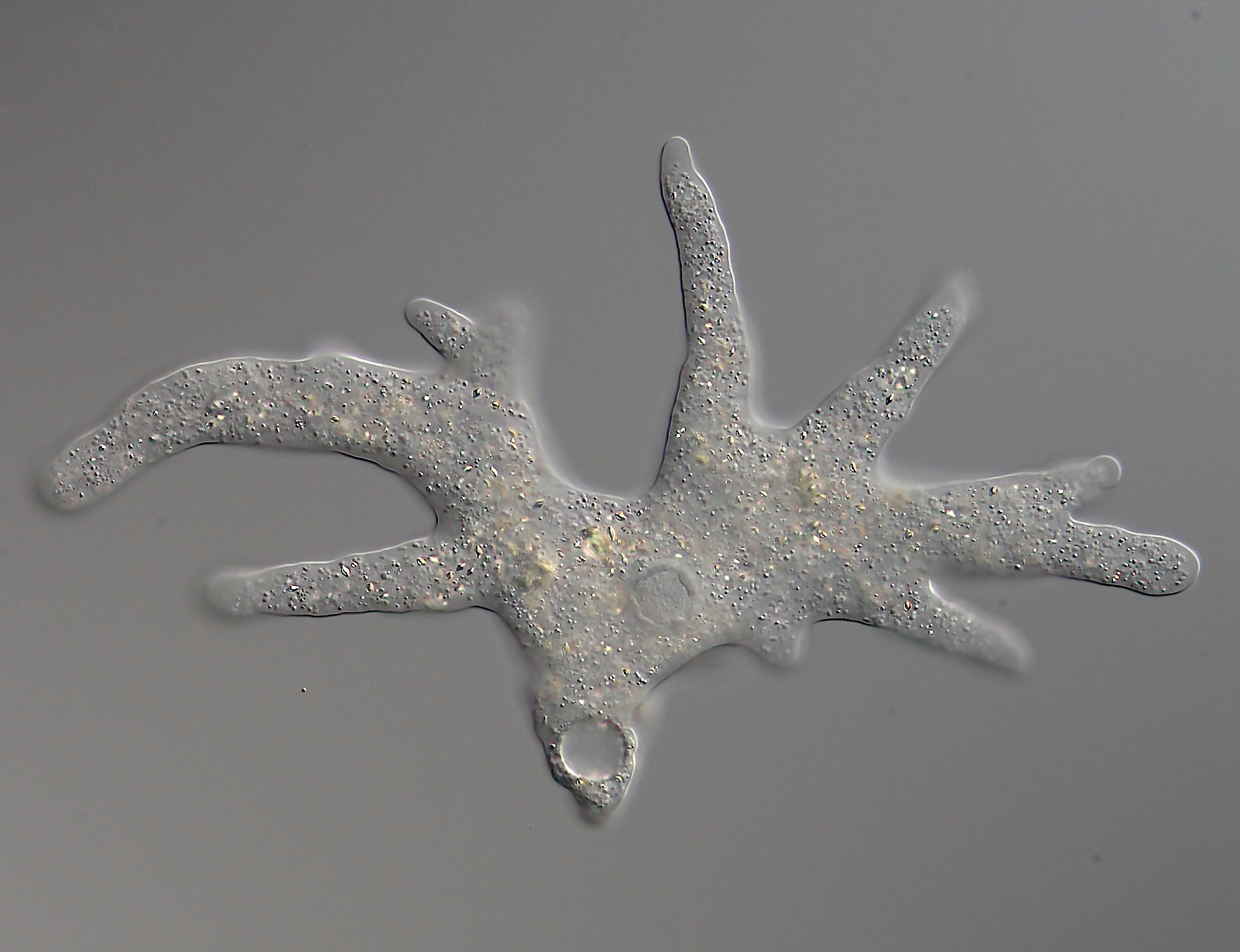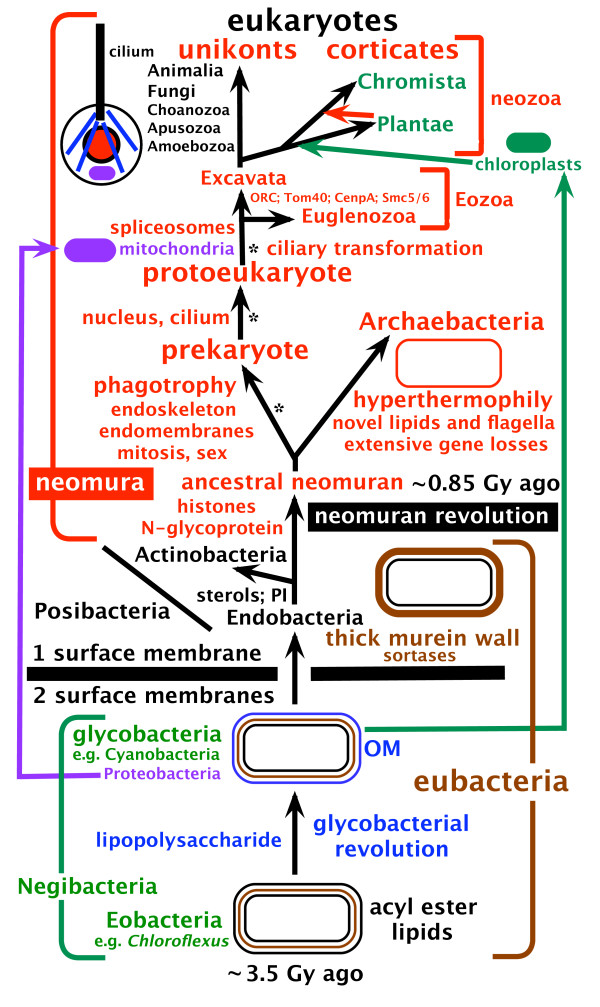|
Apusozoa
The Apusozoa are a paraphyletic phylum of flagellate eukaryotes. They are usually around 5–20 μm in size, and occur in soils and aquatic habitats, where they feed on bacteria. They are grouped together based on the presence of an organic shell or theca under the dorsal surface of the cell. The name derives from the Ancient Greek words for footless () and animal (). This phylum was defined as containing the Breviata and the Apusomonadida. However, it is viewed as paraphyletic, with the Breviata as more basal. The opisthokonts appear to have emerged as sister of the Apusomonadida. It has been suggested that the Mantamonadida be classified in Apusozoa. The Ancyromonadida appear to be Varisulca, Planomonadida, shifting them possibly more basal than the Amoebozoa, or less basal. While some classification systems have placed Hemimastigida in Apusozoa, 2018 research indicated that hemimastigotes (/Hemimastix/ Spironematellidae) are their own supra-kingdom. Characteristics The ... [...More Info...] [...Related Items...] OR: [Wikipedia] [Google] [Baidu] |
Varisulca
Varisulca was a proposed basal Podiate taxon. It encompassed several lineages of heterotrophic protists, most notably the ancyromonads (planomonads), collodictyonids (diphylleids), rigifilids (''Rigifila'', ''Micronuclearia'') and mantamonads. Recent evidence suggests that the latter three are closely related to each other, forming a clade called CRuMs, but that this is unlikely to be specifically related to ancyromonads. Cavalier-Smith had proposed the new subphylum Varisulca which consists of the classes Hilomonadea, Diphyllatea and Glissodiscea. The validity of this proposed taxonomy has yet to ruled upon by the Society of Protistologists. It is unlikely to be widely accepted, since Varisulca appears to be paraphyletic or polyphyletic (ancyromonads are not inferred to be the sister group to CRuMs). Glissodiscea and Multirhiza (a taxon encompassing Diphyllatea and Glissodiscea) also appear paraphyletic or polyphyletic, since ''Mantamonas'' belongs to CRuMs but ancyromon ... [...More Info...] [...Related Items...] OR: [Wikipedia] [Google] [Baidu] |
Apusomonadida
The apusomonads (family Apusomonadidae) are a group of protozoan zooflagellates that glide on surfaces, and mostly consume prokaryotes. They are of particular evolutionary interest because they appear to be the sister group to the Opisthokonts, the clade that includes both animals and fungi. Together with the Breviatea, these form the Obazoa clade. Characteristics Apusomonads are small gliding heterotrophic biflagellates (i.e. with two flagella) that possess a proboscis, formed partly or entirely by the anterior flagellum surrounded by a membranous sleeve. There is a pellicle under the dorsal cell membrane that extends into the proboscis sleeve and into a skirt that covers the sides of the cell. Apusomonads present two different cell plans: *Derived cell plan, represented by '' Apusomonas'', with a round cell body and a mastigophore, a projection of the cell containing both basal bodies at its end. *"''Amastigomonas''-like" cell plan, with an oval or oblong cell that gener ... [...More Info...] [...Related Items...] OR: [Wikipedia] [Google] [Baidu] |
Thecomonadea
The apusomonads (family Apusomonadidae) are a group of protozoan zooflagellates that glide on surfaces, and mostly consume prokaryotes. They are of particular evolutionary interest because they appear to be the sister group to the Opisthokonts, the clade that includes both animals and fungi. Together with the Breviatea, these form the Obazoa clade. Characteristics Apusomonads are small gliding heterotrophic biflagellates (i.e. with two flagella) that possess a proboscis, formed partly or entirely by the anterior flagellum surrounded by a membranous sleeve. There is a pellicle under the dorsal cell membrane that extends into the proboscis sleeve and into a skirt that covers the sides of the cell. Apusomonads present two different cell plans: *Derived cell plan, represented by '' Apusomonas'', with a round cell body and a mastigophore, a projection of the cell containing both basal bodies at its end. *"''Amastigomonas''-like" cell plan, with an oval or oblong cell that g ... [...More Info...] [...Related Items...] OR: [Wikipedia] [Google] [Baidu] |
Apusomonas
''Apusomonas'' is a genus of Apusozoa The Apusozoa are a paraphyletic phylum of flagellate eukaryotes. They are usually around 5–20 μm in size, and occur in soils and aquatic habitats, where they feed on bacteria. They are grouped together based on the presence of an organic shel ... erected by A. G. Aléxéieff in 1924. It includes the species ''Apusomonas proboscidea''. References Apusomonadida Amorphea genera Protist genera {{Unikont-stub ... [...More Info...] [...Related Items...] OR: [Wikipedia] [Google] [Baidu] |
Podiata
Podiates (Cavalier-Smith, 2012, excl. Ancyromonadida) are a proposed clade containing the Amorphea (incl. Opisthokonta, Amoebozoa, apusomonads and breviates) and the organisms now assigned to the clade CRuMs. Ancyromonadida does not appear to have emerged in this grouping. Sarcomastigota (Cavalier-Smith, 1983) is a proposed subkingdom (currently shown to be paraphyletic) that includes all the podiates that are ''not'' animals or fungi. Sulcozoa (Cavalier-Smith, 2012) is a proposed phylum (currently shown to be paraphyletic) within Sarcomastigota that does not include the phyla Amoebozoa (clade In biology, a clade (), also known as a Monophyly, monophyletic group or natural group, is a group of organisms that is composed of a common ancestor and all of its descendants. Clades are the fundamental unit of cladistics, a modern approach t ...) and Choanozoa (paraphyletic), i.e. it includes the proposed subphyla Apusozoa and Varisulca.. References {{Taxonbar, from=Q ... [...More Info...] [...Related Items...] OR: [Wikipedia] [Google] [Baidu] |
Supra-kingdom
In biology, a kingdom is the second highest taxonomic rank, just below domain. Kingdoms are divided into smaller groups called phyla (singular phylum). Traditionally, textbooks from Canada and the United States have used a system of six kingdoms (Animalia, Plantae, Fungi, Protista, Archaea/Archaebacteria, and Bacteria or Eubacteria), while textbooks in other parts of the world, such as Bangladesh, Brazil, Greece, India, Pakistan, Spain, and the United Kingdom have used five kingdoms (Animalia, Plantae, Fungi, Protista and Monera). Some recent classifications based on modern cladistics have explicitly abandoned the term ''kingdom'', noting that some traditional kingdoms are not monophyletic, meaning that they do not consist of all the descendants of a common ancestor. The terms ''flora'' (for plants), ''fauna'' (for animals), and, in the 21st century, ''funga'' (for fungi) are also used for life present in a particular region or time. Definition and associated terms When Car ... [...More Info...] [...Related Items...] OR: [Wikipedia] [Google] [Baidu] |
Hemimastigote
Hemimastigophora is a group of single-celled eukaryotic organisms including the Spironematellidae, first identified in 1988, and the Paramastigidae. Over the next 30 years, different authors proposed placing these organisms in various branches of the eukaryotes. In 2018 Lax ''et al''. reported the first genetic information for Spironemidae, and suggest that they are from an ancient lineage of eukaryotes which constitute a separate clade from all other eukaryotic kingdoms. It may be related to the Telonemia. History of classification Hemimastigophora was established in 1988 by Foissner ''et al''., as a new phylum with a single family, Spironemidae. Its placement on the eukaryote tree of life was unclear, but the authors suggested that the structure of its pellicle and cell nucleus indicated a close relationship with Euglenozoa. For 30 years after the description of the group, no genetic information was available. During that time, researchers proposed that it should b ... [...More Info...] [...Related Items...] OR: [Wikipedia] [Google] [Baidu] |
Thomas Cavalier-Smith
Thomas (Tom) Cavalier-Smith, FRS, FRSC, NERC Professorial Fellow (21 October 1942 – 19 March 2021), was a professor of evolutionary biology in the Department of Zoology, at the University of Oxford. His research has led to discovery of a number of unicellular organisms (protists) and advocated for a variety of major taxonomic groups, such as the Chromista, Chromalveolata, Opisthokonta, Rhizaria, and Excavata. He was known for his systems of classification of all organisms. Life and career Cavalier-Smith was born on 21 October 1942 in London. His parents were Mary Maude (née Bratt) and Alan Hailes Spencer Cavalier Smith. He was educated at Norwich School, Gonville and Caius College, Cambridge (MA) in Biology and King's College London (PhD) in Zoology. He was under the supervision of Sir John Randall for his PhD thesis between 1964 and 1967; his thesis was entitled "''Organelle Development in'' Chlamydomonas reinhardii". From 1967 to 1969, Cavalier-S ... [...More Info...] [...Related Items...] OR: [Wikipedia] [Google] [Baidu] |
Ancyromonadida
Ancyromonadida or Planomonadida is a small group of biflagellated eukaryotes found in the soil and in aquatic habitats, where they feed on bacteria.Cavalier-Smith, T. (2013)Early evolution of eukaryote feeding modes, cell structural diversity, and classification of the protozoan phyla Loukozoa, Sulcozoa, and Choanozoa European journal of protistology, 49(2), 115-178. They are freshwater or marine organisms, benthic, dorsoventrally compressed and with two unequal flagellae, each emerging from a separate pocket. The apical anterior flagellum can be very thin or end in the cell membrane, while the posterior flagellum is long and is inserted ventrally or laterally. The cell membrane is supported by a thin single-layered theca and the mitochondrial crests are discoidal/flat. The group's placement is doubtful, as it seems to fall outside the five supergroups of eukaryotes. Cavalier-Smith considers that they constitute a basal group to Amoebozoa and Opisthokonta and places it togeth ... [...More Info...] [...Related Items...] OR: [Wikipedia] [Google] [Baidu] |
Hemimastigida
Hemimastigophora is a group of single-celled eukaryotic organisms including the Spironematellidae, first identified in 1988, and the Paramastigidae. Over the next 30 years, different authors proposed placing these organisms in various branches of the eukaryotes. In 2018 Lax ''et al''. reported the first genetic information for Spironemidae, and suggest that they are from an ancient lineage of eukaryotes which constitute a separate clade from all other eukaryotic kingdoms. It may be related to the Telonemia. History of classification Hemimastigophora was established in 1988 by Foissner ''et al''., as a new phylum with a single family, Spironemidae. Its placement on the eukaryote tree of life was unclear, but the authors suggested that the structure of its pellicle and cell nucleus indicated a close relationship with Euglenozoa. For 30 years after the description of the group, no genetic information was available. During that time, researchers proposed that it should b ... [...More Info...] [...Related Items...] OR: [Wikipedia] [Google] [Baidu] |
Phylum (biology)
In biology, a phylum (; : phyla) is a level of classification, or taxonomic rank, that is below kingdom and above class. Traditionally, in botany the term division has been used instead of phylum, although the International Code of Nomenclature for algae, fungi, and plants accepts the terms as equivalent. Depending on definitions, the animal kingdom Animalia contains about 31 phyla, the plant kingdom Plantae contains about 14 phyla, and the fungus kingdom Fungi contains about eight phyla. Current research in phylogenetics is uncovering the relationships among phyla within larger clades like Ecdysozoa and Embryophyta. General description The term phylum was coined in 1866 by Ernst Haeckel from the Greek (, "race, stock"), related to (, "tribe, clan"). Haeckel noted that species constantly evolved into new species that seemed to retain few consistent features among themselves and therefore few features that distinguished them as a group ("a self-contained unity"): "perhap ... [...More Info...] [...Related Items...] OR: [Wikipedia] [Google] [Baidu] |
Flagellate
A flagellate is a cell or organism with one or more whip-like appendages called flagella. The word ''flagellate'' also describes a particular construction (or level of organization) characteristic of many prokaryotes and eukaryotes and their means of motion. The term presently does not imply any specific relationship or classification of the organisms that possess flagella. However, several derivations of the term "flagellate" (such as " dinoflagellate" and " choanoflagellate") are more formally characterized. Form and behavior Flagella in eukaryotes are supported by microtubules in a characteristic arrangement, with nine fused pairs surrounding two central singlets. These arise from a basal body. In some flagellates, flagella direct food into a cytostome or mouth, where food is ingested. Flagella role in classifying eukaryotes. Among protoctists and microscopic animals, a flagellate is an organism with one or more flagella. Some cells in other animals may be flage ... [...More Info...] [...Related Items...] OR: [Wikipedia] [Google] [Baidu] |






